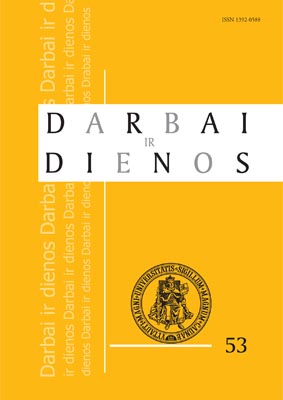Seimo rinkimai Lietuvoje 1920–1926 metais: politinės retorikos ypatumai
The Political Rhetoric of Elections to the Lithuanian Seimas 1920–1926
Author(s): Laima BucevičiūtėSubject(s): Cultural Essay, Political Essay, Societal Essay
Published by: Vytauto Didžiojo Universitetas
Keywords: rinkimai; politinė retorika; spauda; elections; political rhetoric; press
Summary/Abstract: Darbe naudotasi dviem šaltinių grupėmis: 1920–1926 m. periodine Lietuvos spauda ir 1918–1926 m. partijų agitaciniais leidiniais, brošiūromis, suvažiavimų konferencijų medžiaga ir kt. Tyrinėti šaltiniai atskleidė, kad tarpukario Lietuvos spauda iš esmės buvo partinė, atstovavusi vienai ar kitai ideologinei krypčiai, ir solidarizavosi su konkrečia politine srove. Nors to meto visuomenės ir valstybės gyvenimas spaudos puslapiuose vertinamas tendencingai, bet spaudos kaip pagrindinio šaltinio vertė dėl to nemenksta, nes šiam tyrimui itin svarbios subjektyvios, valstybės ir visuomenės santykių briaunas išryškinančios potekstės, kurios padės nustatyti anuometinės politinės kultūros prigimtį. Šio tyrimo tikslas – 1920–1926 m. Lietuvos seimų rinkimų retorikos analizė: kokie motyvai rinkimuose vyravo; kaip rinkimų diskursą veikė to meto aktualijos; kiek dėmesio skyrė tautinėms mažumoms; pagaliau rinkimų retorikos diskurso kaita nuo – nuo Steigiamojo Seimo iki 1926 m. įvykių. This essay analyzes and evaluates the rhetoric employed during parliamentary election campaigns to the Lithuanian Seimas from 1920 to 1926. The Constituent Assembly (Seimas) election in 1920 showed that the preparation of the Lithuanian parties for the election campaign complied with the election requirements. The campaign of 1922 continued previous organizational practice. The rhetoric was again dominated by attitudes towards the Church and land ownership. In addition, the work accomplished during the Constituent Assembly period was criticized but the accusations raised did not serve to broaden political discussion. The assumption seems warranted that the campaign speeches in 1922 showed signs of growing demagogy and populism. The campaign during the 1923 election was determined by the political tension following the dissolution of the Seimas of 1922. The main rhetorical focus in 1923 was on national minorities as the political forces accused each other of organizing international conspiracies. The sharp-toned speeches of the Christian Democrats about the alleged ideological kinship between national minorities and the left-wing forces might have propelled the Christian Democrats to victory in this election. The rhetoric of the 1926 election campaign differed markedly from that of 1920: it no longer exhibited a properly democratic tone of voice. The campaign itself lasted very long – from 1925 onwards. Not having finished their term, the Christian Democrats were widely regarded as de facto political ousiders. During this campaign the sharpness of the political rhetoric on all sides increased immensely. This helped to strengthen the public perception that there were no trustworthy statesmen either in the ranks of the position or of the opposition, which in turn encouraged the spread of nihilistic attitudes toward democracy.
Journal: Darbai ir dienos
- Issue Year: 2010
- Issue No: 53
- Page Range: 139-166
- Page Count: 28
- Language: Lithuanian

